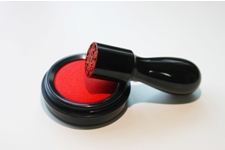Hanko ŌĆō Inkan ŌĆō Insho
- Published 2010.7.13

Insho is a type of seal or stamp which verifies ones authority, using it on official and private documents ensures that the person or group is who they say they are.
Letters or symbols are carved onto the face of the seal. In most cases, Chinese characters are used, but tensho characters or clerical script is also used to make it harder to commit forgery.
Trying to forge an insho is a crime.
Insho are used in Japan, China, Taiwan and other East Asian countries. In all other places, a signature is used in its place.
Insho (ÕŹ░ń½Ā) can also be called hanko (ÕłżÕŁÉ), han (Õłż), or in (ÕŹ░). The impression made from the insho on a piece of paper is called the inŌĆÖei (ÕŹ░ÕĮ▒ lit. seal shadow). The words insho (ÕŹ░ń½Ā)and inkan (ÕŹ░ķææ) originally meant the stamp and the impression on paper, respectively, but now they are both interpreted as the same thing.
Materials of Insho
Insho are commonly made from wood, ivory, or water buffalo horns.
